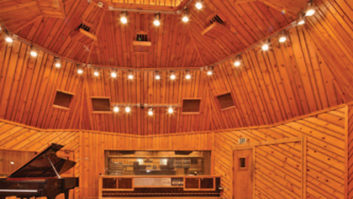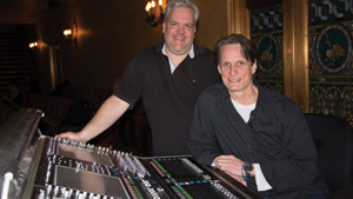
Kinky Boots opened at the Al Hirschfeld Theatre on West 45th Street in April 2013.
The new musical Kinky Boots made an immediate, triumphant splash in its Broadway debut this year, beginning its open-ended run at the Al Hirschfeld Theater on West 45th Street on April 4 and then garnering 13 Tony Award nominations en route to six wins on June 9. This high-spirited production is the brainchild of the all-star creative team of multiple Tony Award winners Harvey Fierstein (book writer) and Jerry Mitchell (director/choreographer), and Grammy Award–winning pop music superstar Cyndi Lauper, who made her Broadway debut as composer and lyricist and became the first female solo songwriter to win a Tony.
Inspired by a true story, and reimagined from the 2005 Miramax film of the same name, Kinky Boots tells the tale of young businessman Charlie Price (Tony nominee Stark Sands), who is compelled to leave his pursuits in London and return to his late father’s bankrupt shoe factory in Northampton, England, to try to save it. At the factory, Price meets Lola (Tony winner Billy Porter), an entertainer and cross-dresser who needs a pair of high-quality stilettos and senses a profitable opportunity in manufacturing ladies’ shoes for men. Price and Lola work together to save the family’s business and find their common ground in the process.
To help tell this story, Lauper composed a lively pop-rock score performed by a 13-piece orchestra (synths, guitars, drums, strings, reeds and horns), directed by Brian Usifer. If you are counting at this point, four of Kinky Boots’ six Tony wins are a testament to the appeal and impact of its music: Best Musical, Best Original Score (Music and/or Lyrics) Written for the Theater, Best Orchestrations, and Best Sound Design of a Musical, which went to veteran sound designer and engineer John Shivers, whose previous Broadway credits include Bonnie and Clyde, Hugh Jackman Back on Broadway, Sister Act, 9 to 5, Cat on a Hot Tin Roof, The Little Mermaid, Tarzan, In My Life, and Billy Crystal’s 700 Sundays.
“My first exposure to Cyndi’s score was actually at the reading we did in New York in January of 2012,” Shivers says. “I really liked it right from the start; it was unique and fresh. It was also immediately clear that we were going to need to enhance or at least support the pop influences of the score with a solid and punchy reinforcement system. I felt so fortunate to have Stephen Oremus there as the orchestrator/arranger. He is a true talent with a huge breadth of knowledge in many genres of music and he is a great collaborator. We, together, were able to carve out a sound most appropriate for Cyndi’s pop/Broadway score.”
Kinky Boots’ producers mounted its first, pre-Broadway production in Chicago at the Bank of America Theatre, where it played in October and November 2012. In Chicago, Shivers specified the house audio system that carried over to Broadway, working with Scott Kalata of Masque Sound in East Rutherford, N.J., a leading theatrical sound reinforcement design and installation company. “I have had an excellent relationship with Masque for nearly two decades,” Shivers says. “They offer a combination of excellent technical services and creative solutions to fully support our design needs.”

David Patridge and John Shivers at the DiGiCo SD7T
Photo: Lisa Kovarik
“I’ve been working with John for many years now, overseeing his specifications and making sure the shop is able to provide all the equipment that he requires,” Kalata says. “That includes anticipating things he might need and getting them all incorporated into his projects. It’s a pleasure to work with somebody who is so well organized and knowledgeable.”
Shivers’ equipment package for Kinky Boots includes a DiGiCo SD7T digital mixing console, TC Electronic Reverb 6000, Sennheiser SK 5212 transmitters, d&b audiotechnik E-Series small-scale speakers for surrounds, L-Acoustics 108P self-powered compact coaxial speakers for the foldback, and Meyer Sound MINA and M’elodie line array loudspeakers for left/right/center coverage, as well as a rear delay cluster of five M1D line array loudspeakers, plus six 500-HP and two 700-HP subwoofers. Five Galileo 616 processors handle system drive and alignment.
Shivers notes that when the production moved into the Al Hirschfeld Theatre, he found that “the box seats…pretty much tuck right up against the proscenium, so the seats running along the sides of the orchestra seating section are very much shaded from the side arrays. The team at Masque was able to provide additional speakers to make sure those seats were covered, and to overcome that obstacle.
“The objective was to have equal distribution of sound to every seat in the house, and to be sure to achieve a solid and punchy sound to meet the needs of the pop nature of the show,” Shivers says. “The 108P is one of my favorite fill speakers. It provides a great deal of clarity and SPL in a very small package. Meyer products and the MINA in particular were well-suited for our needs. The MINA is a small yet powerful speaker system, and accomplished both the sonic quality we were looking for while remaining unobtrusive enough to meet the visual aesthetic requirements. The Galileo is very flexible, has great EQ, and the seamless integration with the MAPP Online Pro prediction program is quite helpful.”
Kinky Boots’ associate sound designer and front-of-house engineer is David Patridge, whom Shivers has known since 1990 and regularly collaborated with since 2005. “Nobody is better or quicker than David at putting a solid mix together,” Shivers says. “Once the rough mix is in place, we work together to refine it and create a dynamic shape to the show.”
“Our approach [to the FOH mix] is probably similar to many engineers out there and comes from a number of years doing live music before doing Broadway shows,” Patridge says. “Choose great mic positions, establish a sensible gain structure, listen carefully to the sounds from each instrument and maybe re-choose the great mic positions. Building a mix starts with the rhythm section and then moves out from there. We tend to use a bit of stereophony to make a more interesting soundstage, but you need to constantly be vigilant regarding the prime directive, which is to tell the story. The vocals need to be intelligible and have enough space in the mix to be comfortably heard. A musical is the sum of many parts, and nobody will appreciate the sparkle in the sound of the toms or the lush strings if the vocals can’t be heard.”
One key aspect of Shivers’ sound design for Kinky Boots is achieving isolation and clarity, to allow for mixing control over the musical instruments, which he points out is critical for delivering a pop-music score. At the Hirschfeld, he says, the orchestra is configured in “a pretty traditional layout, with the exception of the drums,” which he placed in a room on the building’s fifth floor. “While this is perhaps not ideal from a communication standpoint, it does completely negate the bleed from the drums into other instrument mics. Other players are placed in such a way to minimize their effect on each other, as well. In the pit, the winds are house-left, the keyboards and guitars in the center, and the strings house-right.” The orchestra pit is outfitted with an Aviom monitoring system; drummer Sammy Merendino is connected to the orchestra via audio and video feeds.
Both Shivers and Patridge note that the two factors that most affect each night’s mix are the variations in each performance, and temperature and humidity. “The idea is to generate as consistent a mix from show to show as possible,” Shivers says. “The challenge is to make this happen with constantly changing input. So you are really continually dialing in a new mix to one degree or another.”
“We try to put it in the pocket for the audience every night but there are always differences,” Patridge adds. “We have been fortunate to have had full houses every show so at least we don’t need to deal with the differences that occur with the sound between an empty house and a full house!”



